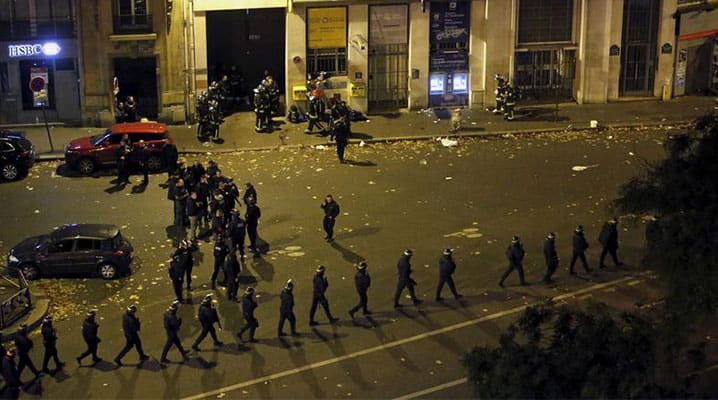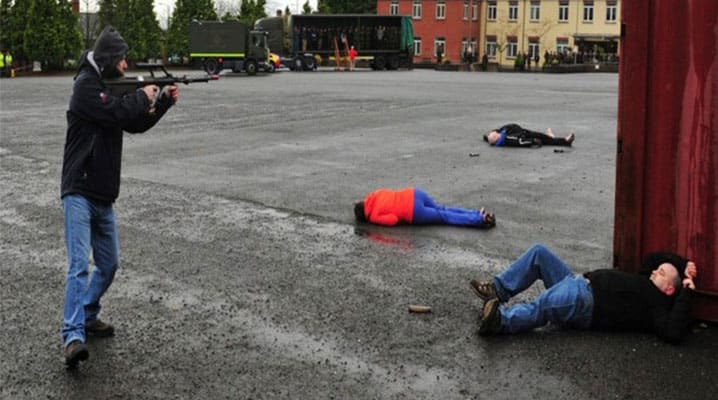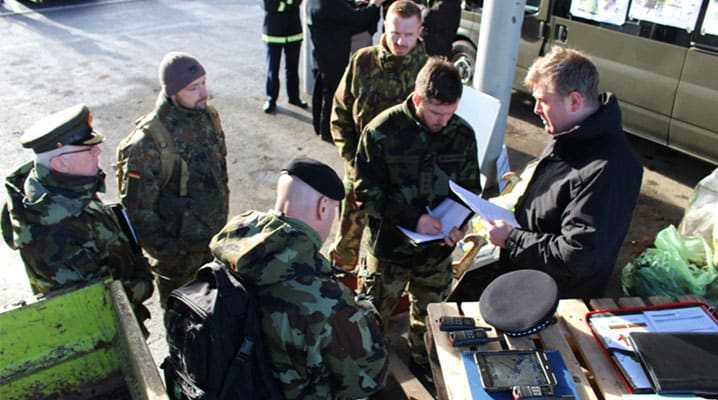The frequency of complex terrorist attacks is on the rise – and not only in operational environments such as Afghanistan and Iraq. Civilians have recently been targeted in incidents involving multiple actors in cities across the globe, including Nairobi, Paris, St. Bernadino, Jakarta and Brussels. It is essential to prepare commanders to respond effectively under the complex conditions of marauding terrorist attacks, when they will face a blizzard of information and will need to command a myriad actors to end the event with minimal casualties. With NATO support, a specialised course at the Ordnance School of the Irish Defence Forces sets out to do just that.

French police with protective shields walk in line near the Bataclan concert hall following fatal shootings in Paris, France, 14 November 2015.
© REUTERS
Marauding terrorist attacks can take many forms: from the complex assaults in Brussels (22 March 2016) and Paris (13 November 2015) to the single shooter attack on tourists in Sousse, Tunisia (26 June 2015), to the use of vehicles and knives. Due to the dynamic nature of such attacks, it has proven difficult to prepare our security forces, including first responders, to deal with these situations. One very important lesson we have learnt over the last number of years, particularly in Afghanistan and Iraq, is that improving people’s situational awareness helps mitigate the effects of the terrorist attacks.
One innovative aspect of this year’s iteration of the Counter Marauding Terrorist Attack (C-MTA) course, which took place from 13 to 17 November, is that a significant amount of course time is dedicated to Advanced Situational Awareness Training. This training allows people to understand "what the absence of the normal and presence of the abnormal may mean". Arming security forces with the appropriate equipment and situational training certainly makes them better prepared to deal with these dynamic situations.
A course for commanders
The Ordnance School in County Kildare conducted the first Commanders’ Counter Marauding Terrorist Attack (C-MTA) course in November 2015.
Building on its extensive experience in international efforts to counter improvised explosive devices (C-IED), the School had already delivered model courses to share expertise in this area with civilian and military personnel from EU and NATO member states as well as NATO partner countries. The C-MTA course concept was a natural progression of these efforts and also built on the analysis and examination of both the United Kingdom’s Marauding Terrorist Firearms attack programme and the United States’ Active Shooter programme.

A police sharpshooter takes aim from a helicopter hovering over rooftops following bomb attacks in Brussels, Belgium, March 22, 2016.
© REUTERS
The C-MTA course focused on three central aspects:
1. Using the C-IED construct as a blueprint to foster interaction among different entities (including police units, Explosive Ordnance Disposal teams, and Special Forces, etc.) and to develop operational tools and tactical methods as well as strategic direction.
2. Leveraging the C-IED network, developed over many years, which brings together the ideal range of security forces, government agencies, emergency services, academics and subject-matter experts.
3. Using lessons identified from terrorist attacks in the military operational environment to enhance the responses of civilian and military actors dealing with terrorist attacks in our countries.
Lastly, the aim of the course from the outset was not to offer a single system but rather to provide international students with a range of options. It is up to each organisation to decide if the knowledge imparted to students and trainees is suitable for use in their respective countries.
NATO recognised the importance of this course from its inception by providing funding through NATO’s Voluntary National Contribution Fund (VNCF), which had also previously supported the School’s C-IED courses.
Lessons learned
November 2017 sees the third iteration of the course, which has changed substantially from its first outing, thanks to a comprehensive lessons learned process. Among the many changes that have been introduced are the employment of a private sector security company and the sourcing of instructors from a wider range of providers and individuals to promote diversity in the development of solutions.
Private companies are also comprehensively engaged as part of the training experience – the private sector clearly has a huge interest in this area given their exposure and their concern about what options they have in the first critical minutes of any attack.

The Counter Marauding Terrorist Attack course addresses what happens when the shooting starts and essentially ‘all bets are off’.
Photo courtesy of the Ordnance School, Defence Forces Ireland
The focus of the course has also increased to ‘advanced’ level allowing for an immersive approach to operational command and less emphasis on tactical engagement.
Training methodology
The course architecture relies on three fundamentals in training methodology: theoretical, practical and academic. Students are first exposed to the course concept followed by an introduction to a generic command framework for marauding terrorist attacks. An operational framework is the key for success in an event where the number of casualties is the principal determinant of success or otherwise.
The students benefit from learning based on experience developed from the successes, and failures, of personnel who have been involved in actual marauding terrorist attacks. This learning is critical and represents a cornerstone of the C-IED effort. To make sense of the loss of so many lives, every effort must be made to learn from such attacks so that others may adapt and survive. Tactical medicine is also covered as another important element of the course curriculum.
The students engage through practical cooperation with private sector entities and are put through syndicate exercises directly with concerned parties. A lack of engagement from the security services is a common complaint across many countries and exposure in this area on the course has yielded many positive outcomes.
The course has paired with Airbox Systems (MOSAIC) and Klas Telecom to provide an introduction to operational tools that are essential for success in the complex attack scenarios envisaged. This pairing has allowed the school to challenge the students in table-top exercises in ‘low-tech’ (maps and boards) and ‘high-tech’ (Common Operational Picture & Tactical Edge Communications).

Participants in the Counter Marauding Terrorist Attack course benefit from experiential learning developed from the successes, and failures, of personnel who have actually been involved in such events.
Photo courtesy of the Ordnance School, Defence Forces Ireland
Lastly, the students are exposed to academic learning in both analysis of recent events and the mental conditioning required for the information blizzard that they will face under complex conditions. The course design addresses what happens when the shooting starts. A multitude of efforts are designed to address the intelligence picture, community engagement, radicalisation etc. However, this course is solely directed towards effective command of the myriad actors required to end the event with minimal casualties.
Designed to reduce the risk of responders being killed, a Command Level Advanced Situational Awareness Training module has been introduced into the November 2017 course. It adapts the successful US Marine Corps Combat Hunter programme to a marauding terrorist environment. Boeing Defence will provide situational awareness analysis focused in the ‘right of bang’ environment familiar to proponents of C-IED (that is, training leaders to deal with a dynamic terrorist event after it has begun and is underway). Boeing has essentially added a scientific component to experiential learning.
Overall, the 2017 course will build on the success of the first two iterations. The Ordnance School will provide input on countering and defending against IEDs at command level, as well as managing and directing the course. Diversity in both instructors and students promises to provide for a challenging and dynamic output.
Military lessons for civilian responders
The inclusion of the military in every effort to develop a sound C-MTA response plan is a key enabler for success in this endeavour. Many military theatres of operation have proved to be enormously challenging, resulting in expertise that does not exist in any civilian agencies. No single state entity has the ability, skills or resources to respond to these attacks on its own. The terrorists that have undertaken these kinds of attacks in our homelands thus far have had minimal, if any, military training and have been lightly armed or utilised available resources such as vehicles and knives – and yet they tax our capacities immensely.
Our experience from operational theatres, coupled with a thorough understanding developed by experienced military operators, points towards the possibility of more complex attacks in our homelands further down the road. So, we cannot afford to be complacent. The military has the experience and knowledge required to prepare and work with all actors to meet this developing threat. Lessons learned and capabilities developed from this course – which involves students from emergency services, private sector and other state agencies – could be replicated at a national level.
